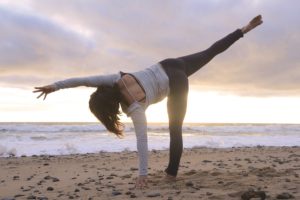Have you ever been in a yoga class and thought to yourself, “I don’t look like the teacher or the person next to me — I must be doing this wrong”? Me, too.
For about a decade, I pushed myself into urdhva dhanurasana (wheel pose) and salamba sarvangasana (shoulder stand) with great effort and discomfort. Teachers would show us what a pose should look like, and it always seemed to me the goal was a sort of aesthetic result.
I never once considered the possibility that my upper arm bones were shorter than those of the person next to me and maybe that was why I couldn’t reach the ground. I just thought I wasn’t a very good student. This is where we get yoga practice wrong in the West. We use asana — the physical postures — as a measure of worth. Maybe practicing harder would get me there.
Nearly all modern-day yoga instruction centers on tensile functions of the body and aesthetics. Relax, stretch, twist, reach, make space, breathe. Move like this. Look like that.

Many of my friends have told me about unfamiliar teachers adjusting them to make them look a certain way, to match the rest of the class, or to demonstrate a pose. Sometimes, that’s the easiest way for a teacher to get the point across. But it can set students up for a disappointing yoga practice. The difference is discernment.
Paul Grilley is an author, anatomy teacher, and a prominent instructor of yin yoga — a slower style that focuses on deep connective tissues — who explains that we shouldn’t look only at the musculo-skeletal systems or tissues involved in a yoga pose. Instead, he teaches us to look at four main components of practice: tension, compression, proportion, and orientation.
Tension deals with tissues and is probably the most easily understood part of our practice. We often refer to muscles and tissues within a yoga practice: tight hamstrings, overdeveloped shoulders, a tight back.
But when Grilley talks about compression, proportion, and orientation, he’s speaking of the way our bones influence our practice.
If you attend a workshop with Grilley, he’ll likely have his bones with him. Femurs lined up in a row demonstrate not just differences in their lengths, but variations in the head and neck of the bone and its relationship to a hip socket. Hip sockets differ in orientation and depth, too. These structural differences will influence how people look and feel in a yoga pose — in ways that have absolutely nothing to do with ability.
The reason you don’t look like the yogi next to you in class is largely not due to your ability or how hard you practice, or your intrinsic worth as a student. That is why it is so important to consider not only what a pose should look like but also what it could feel like.
Grilley offers a way to begin. When you practice a pose and reach an uncomfortable moment, the fundamental distinction to make is this: “Is what I’m feeling tension or compression?”
Tension deals with muscular and tissue tightness, whereas compression is determined by the shape and natural orientation of our bones. It is not always easy to tell the difference. The safest bet? Stop pushing, just notice.
Our yoga practices can greatly influence the tissues of our bodies. And with greater muscular flexibility comes a sense of freedom in movement. But when it comes to our bones, they are the inherent scaffolding. They create the shape and the structure of a pose.
Leslie Kaminoff, another anatomy-influenced yoga teacher, talks about asana as “getting the tensile and compressive forces in our bodies into a state of balance.”
That is to say, the yoga practice can be a place of effort as well as intimate knowledge about what works best for you, including where your physical compressive limits are.
When we step back into studios and start practicing together again, I hope that we don’t let our eyes wander to the students next to us in search of the perfect pose. Instead, let’s take a deep breath together and marvel at the variously shaped scaffolding that has carried us each through the past year.



